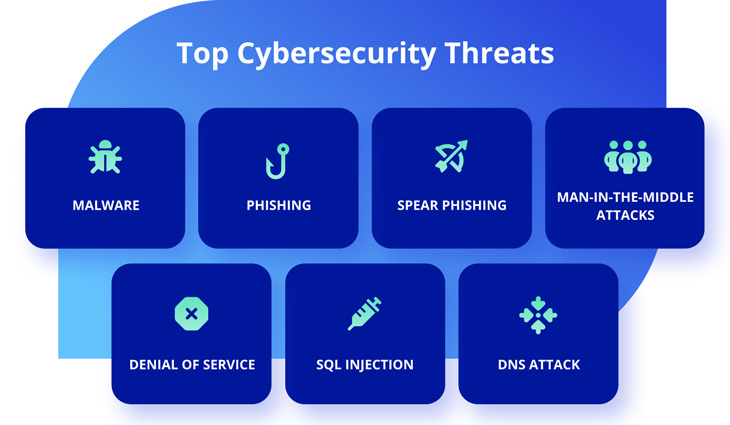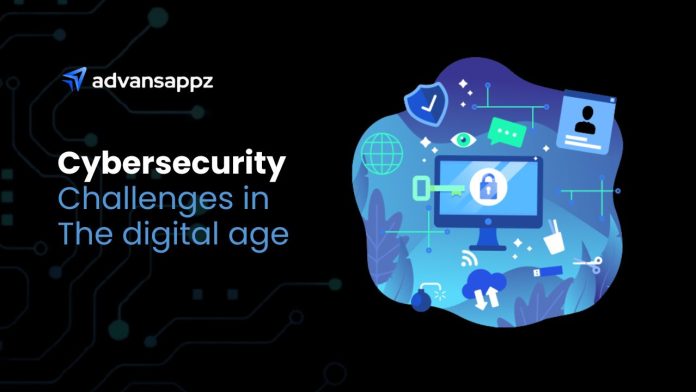Recent statistics reveal that cybercrime is projected to cost the global economy a shocking $10.5 trillion annually by 2025. This alarming information highlights the severity of the situation we are facing. To address this critical issue, one needs to learn the common cybersecurity challenges that arise in the digital age and emphasize the significance of having strong cybersecurity measures in place to protect our digital domains.
This blog discusses the constantly changing landscape of cyber threats and the difficulties individuals and organizations encounter in protecting their digital resources. We will also understand how cybersecurity services can eliminate risks and help achieve a secure digital environment for industries across the globe.
Let’s get started!
Common Cybersecurity Challenges You Should Know

- Phishing Attacks: Phishing attacks use fraudulent emails, messages, or websites to deceive people into disclosing sensitive information like login credentials or financial details. Scammers often pretend to be trusted organizations like banks or well-known online services, so it’s essential to exercise caution when sharing personal data online.
Example: A phishing email pretending to be from a reputable online retailer requests the recipient to update their credit card information by clicking on a fraudulent link.
- Ransomware Attacks: Ransomware is harmful software that encrypts files on someone’s device, making them impossible to access until payment is made. These attacks can have severe consequences, resulting in financial losses, disrupted operations, and compromised data.
Example: A healthcare facility experiences a ransomware attack, causing critical patient records to be locked and disrupting medical services until a ransom is paid.
- Malware Infections: Malware refers to malicious software designed to harm or gain unauthorized access to computer systems. It can come in various forms, such as viruses, worms, or Trojans. Once infected, techniques can be used to steal sensitive information or launch further attacks.
Example: A user unknowingly downloads a seemingly harmless file from an untrustworthy website, which infects their computer with keylogger malware, allowing hackers to capture sensitive keystrokes.
- Insider Threats: Insider threats arise when individuals within an organization misuse their authorized access to compromise security. This can include deliberate actions or unintentional mistakes, leading to data breaches or unauthorized disclosures.
Example: An employee with access to customer data sells confidential information to a competitor for personal gain, compromising the organization’s reputation and trust.
- Data Breaches: Data breaches occur when unauthorized individuals access sensitive data organizations store. Breached data can include personal information, financial records, or intellectual property. The outcomes of a data breach can be far-reaching, resulting in financial losses and damaged customer trust.
Example: A cybersecurity firm experiences a data breach, exposing its clients’ confidential security protocols and compromising their competitive advantage.
- Distributed Denial of Service (DDoS): DDoS attacks occur when a network or website is flooded with enormous traffic, making it impossible for legitimate users to access it. Such attacks can cause disruptions of online services, resulting in financial losses and harm to reputation.
Example: An online retail platform faces a DDoS attack during a peak shopping period, causing its website to crash and resulting in lost sales and dissatisfied customers.
- Weak Password Security: Weak or easily guessable passwords provide an entry point for cybercriminals. Password reuse and lack of password complexity make accounts vulnerable to brute force attacks or credential stuffing.
Example: A user sets the same weak password for multiple online accounts, and when one of those accounts is compromised, hackers gain unauthorized access to all associated accounts.
- Internet of Things (IoT) Vulnerabilities: The rapid proliferation of IoT devices brings new security challenges. Insecure IoT devices can be compromised, allowing hackers to gain unauthorized access to networks, invade privacy, or launch attacks.
Example: Hackers exploit vulnerabilities in smart home devices, gaining access to home security cameras and compromising homeowners’ privacy.
- Lack of Security Awareness: The lack of cybersecurity awareness among individuals and employees poses a significant challenge. Insufficient knowledge about potential threats, safe online practices, and phishing awareness can make individuals more susceptible to cyber-attacks.
Example: An employee falls victim to a phishing email, unknowingly clicking on a malicious link that installs malware on their company-issued device.
- Evolving Threat Landscape: Cyber threats are constantly changing, with attackers employing new techniques and leveraging emerging technologies to exploit vulnerabilities is crucial to stay updated with the changing threat landscape and take proactive security measures.
Example: There is a significant threat to individuals and organizations from cybercriminals who create new malware targeting vulnerabilities in Internet of Things (IoT) devices.
- Blockchain: Blockchain and cryptocurrency are crucial for businesses, but cyberattacks pose significant challenges. These technologies have yet to reach an advanced, secure stage, resulting in numerous attacks. So, companies must be aware of security challenges and prevent intruders from exploiting gaps.
Example: One example of a blockchain attack is the 51% attack in 2018 on the cryptocurrency network Ethereum Classic (ETC). Ethereum Classic is a blockchain that split from the main Ethereum blockchain following a contentious hard fork.
How Can Cybersecurity Sevices Help?

Cybersecurity services play a crucial role in mitigating and addressing the various threats faced in the digital landscape. Here are some ways in which cybersecurity services help combat cyber threats:
- Threat Detection and Prevention: Cybersecurity services employ advanced technologies and tools to detect and prevent threats proactively. They use robust security measures such as firewalls, intrusion detection systems, and antivirus software to identify and block malicious activities, minimizing the risk of successful attacks.
- Incident Response and Management: In the event of a cyber attack, cybersecurity services deliver incident response and management. Their expertise helps analyze the incident, assess the extent of the breach, and implement effective remediation strategies.
- Vulnerability Assessments and Penetration Testing: Experts can identify weaknesses in systems and networks by conducting regular vulnerability assessments and penetration testing. By simulating real-world attack scenarios, they assess the security posture of organizations and provide recommendations to address vulnerabilities.
- Security Awareness and Training: Cybersecurity solutions offer comprehensive security awareness programs and training sessions to educate employees about potential threats and best practices.
- Security Monitoring and Analytics: Cybersecurity services continuously monitor networks, methods, and data to identify real-time suspicious activities and potential threats. They leverage state-of-the-art security analytics and machine learning techniques to detect patterns and anomalies, enabling early detection and swift response to potential breaches.
- Data Protection and Encryption: These services implement robust data protection measures such as encryption, tokenization, and access controls. By safeguarding sensitive data, they ensure its confidentiality and integrity, declining the risk of data breaches.
- Compliance and Regulatory Support: Cybersecurity services provide guidance and assistance in implementing security controls and frameworks to meet industry-specific standards, ensuring adherence to legal and regulatory obligations.
- Threat Intelligence and Research: Cybersecurity services maintain up-to-date threat intelligence and conduct ongoing research to stay informed about emerging threats and evolving attack techniques. This enables them to anticipate and proactively defend against new and sophisticated cyber threats.






